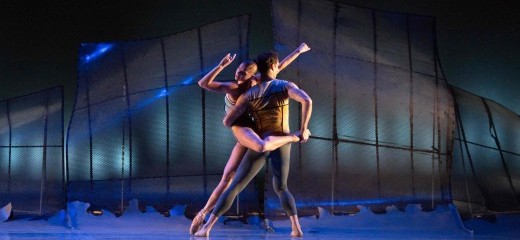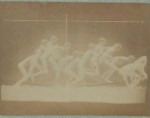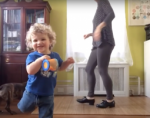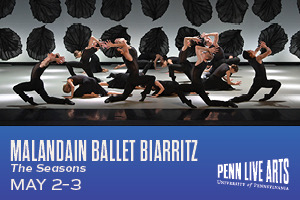
PAB: Pointe and Break
by Lynn Matluck Brooks
Wheeldon’s DGV, which closed the evening, took us out of Chroma’s architectural enclosures to a different world, perhaps a distant planet, far, far away. The roiling forms of Jean-Marc Puissant’s translucent set created an irregular upstage screen behind which the dancers bobbled, lurched, and strutted across the upstage area, emerging forward through a just-large-enough incision to confront us with powerful duets and group encounters that showed off each couple in exuberant commitment to the challenging but playful dance. A wonderful change since Corella took over company leadership is that we are seeing long-time PAB dancers looking fresh and joyous; in DGV, I was particularly delighted with Amy Aldridge’s pairing with Alexander Peters, and Lauren Fadeley’s with James Ihde. But the real star in this work was the set’s weirdly wonderful world, highlighted by Jennifer Tipton’s extraordinary lighting. The minimalist yet insistent music, by Michael Nyman, ran from mildly hysterical to over-the-top, the least successful element in this collaboration (Puissant designed the attractive corset-like costumes).
Smack-dab in the middle of these two twenty-first-century ballets, Corella wisely set George Balanchine’s 1940 Concerto Barocco, to J.S. Bach’s Concerto in D minor for Two Violins (soloists were Luigi Mazzocchi and Dayna Hepler). The music alone lifted the work to an Elysian Field of gracious, courtly elegance, but Balanchine’s reverence for symmetry (and care when breaking it), respect for balletic form (and care when departing from it), and impeccable musicality (and wit when syncopating movement against music) occupied that same high ground. It also grounded the two more recent works in the earlier master’s experiments with contemporizing this classic dance form. I have seen PAB do Balanchine before (they are a Balanchine-derived company, as founder Barbara Weisberger ensured), and I have shivered as the work exposed the dancers’ flaws. This time, I felt fully confident watching the work, as the dancers themselves clearly did, too. That they muffed one complex series of arm accents over bounces en-pointe did not entirely destroy the Apollonian aplomb of the work, and I would bet they nailed it at subsequent shows.
If you haven’t seen PAB since Corella took over the helm, get there.
By Lynn Matluck Brooks
October 25, 2015











